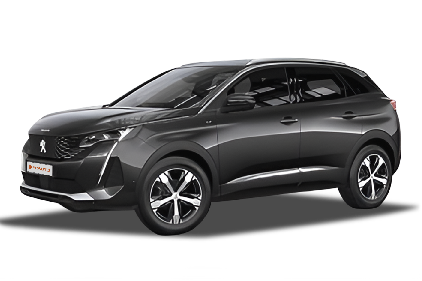Q
How long will a Peugeot 3008 last?
How long a Peugeot 3008 lasts really comes down to a bunch of things: how you take care of it day in and day out, your driving style, and let's not forget Malaysia's unique road conditions and climate. Keep up with the official recommended maintenance schedule and treat her right, and this SUV should have no trouble hitting 150,000 to 200,000 km – maybe even more. That turbocharged engine and the clever chassis tech underpinning it are built to take a beating, and it shows, whether you're stuck in city traffic or cruising down the highway for hours on end.
Now, Malaysia's heat and humidity can be tough on rubber parts and electronics, so I'd definitely advise owners to pay extra attention to checking the cooling system and electrical bits regularly. Sticking with genuine parts will also go a long way in keeping it running strong for longer. When it comes to repairs, the 3008 sits somewhere in the middle of the pack for European cars cost-wise. But if you find a reputable specialist garage or stick with an authorized service center, you can be sure the job's done properly.
For Malaysian owners, nailing that maintenance schedule and avoiding overly aggressive driving are the real keys to stretching the life of your 3008. Oh, and let's not overlook resale value – Peugeots tend to hold their own pretty well on the used market here, so keeping it in good nick will definitely help when it's time to upgrade.
Special Disclaimer: This content is published by users and does not represent the views or position of PCauto.
Related Q&A
Q
Is the 2019 Peugeot 3008 reliable?
The 2019 Peugeot 3008 holds up pretty well in terms of reliability in the Malaysian market. This SUV has won over many consumers with its distinctive design and generous equipment levels. The 1.6-liter turbocharged engine paired with the 8-speed automatic gearbox delivers a solid balance of power and fuel efficiency, making it a good fit for both city commutes and longer road trips. Peugeot has always excelled at tuning their chassis for comfort, and the 3008's suspension does a commendable job of ironing out road bumps, enhancing the overall ride quality.
Step inside, and the 3008 impresses with high-quality materials and that cool i-Cockpit digital setup, which gives the interior a nice tech-forward vibe. That said, some owners have mentioned occasional minor glitches with the electronic systems. It's a good idea to check for software updates during regular servicing to keep everything running smoothly.
For Malaysian buyers, Peugeot's after-sales network is relatively well-established, with authorized service centers in major cities and parts supply generally being timely. If you're looking at a used model, it's definitely worth checking the service history, and prioritizing ones with main dealer servicing will help reduce potential headaches down the line.
All in all, the 2019 Peugeot 3008 is a stylish and practical SUV. As long as you keep up with regular maintenance, its reliability should be more than adequate for everyday use.
Q
How much does it cost to replace a timing belt on a Peugeot 3008?
The cost to replace the timing belt on a Peugeot 3008 typically ranges from RM1500 to RM3000. The exact price depends on the model year, engine type, and where you choose to have the work done. Dealership service centers will generally charge more, while independent garages might offer more budget-friendly options. It's a good idea to shop around and get quotes from a few different places before making a decision.
The timing belt is a critical engine component, responsible for keeping the crankshaft and camshaft in sync. If it snaps, it can cause major engine damage, so it's crucial to follow the manufacturer's recommended replacement interval – usually between 60,000 to 100,000 kilometers – to avoid much bigger repair bills down the line. Malaysia's hot and humid climate can also speed up belt degradation, so regularly checking the belt's condition is especially important. If you notice any cracks or signs of wear, get it replaced promptly.
Additionally, when replacing the timing belt, it's generally advisable to swap out the water pump and tensioner at the same time. These parts work hand-in-hand with the belt, and replacing them together saves on future labor costs from having to disassemble everything again later, plus it ensures the long-term reliability of your engine.
Q
Does the Peugeot 3008 have a wet belt?
Right, some diesel-powered Peugeot 3008 models do come with a wet timing belt setup, specifically the earlier 1.6-liter BlueHDi diesel engines. This design submerges the timing belt in engine oil, which helps cut down on noise and can potentially extend its lifespan. But here's the thing: you *must* stick to the manufacturer's recommended service intervals – usually around 100,000 kilometers or 6 years, whichever comes first – for inspections and replacement. Skip that, and you could be looking at belt degradation leading to oil contamination or, worse, catastrophic engine damage.
It's worth noting that Peugeot has moved towards the more traditional timing chain design in their newer petrol engines, like the 1.2T PureTech. For Malaysian 3008 diesel owners, nailing the wet belt maintenance means using the right oil – specifically low-ash stuff that meets Peugeot's specs, think 0W-30 C2 grade. Also, avoid lots of short, stop-start trips; that can lead to oil dilution issues. My advice? Regular visits to an authorized service center for diagnostics to keep that lubrication system in tip-top shape.
And hey, Peugeot isn't alone here – some Ford models use similar wet belt designs too. So, it's always a good idea to get familiar with your owner's manual and keep detailed records of your service history. That way, you stay ahead of the game.
Q
How often should a Peugeot 3008 be serviced?
According to Peugeot's official guidelines, the standard service interval for the Peugeot 3008 is every 12 months or 15,000 to 20,000 kilometers, whichever comes first. This schedule applies to the common 1.6L turbocharged petrol and 2.0L diesel variants in Malaysia, though intervals might shift slightly depending on driving conditions or the vehicle's age. Malaysia's hot, humid climate and stop-start city traffic can speed up oil degradation – if you're mostly doing short trips or regularly pushing the engine hard, it's wise to check oil and filters around the 10,000km mark instead.
The 3008's PureTech and BlueHDi engines use long-life synthetic oil, but regular changes are still critical – especially since turbo systems demand super clean oil. We recommend keeping tabs on maintenance needs through the car's on-board service reminder or the MyPeugeot app. Also, with Malaysia's rainy seasons, don't forget to give your brakes and wiper blades extra checks before and after.
For 3008s over 5 years old, consider shortening service intervals a bit. This helps keep an eye on aging rubber components and hoses. And remember: sticking to the factory service manual isn't just about keeping your powertrain warranty valid – it also ensures systems like the AdBlue setup (on diesels) and stop-start function keep working reliably for the long haul.
Q
Do Peugeot 3008 hold their value?
The Peugeot 3008 holds its value moderately well in the Malaysian market, pretty much on par with most European SUVs. Its resale worth tends to be influenced by brand perception, market demand, and fluctuations in new car prices. Compared to Japanese rivals like the Honda CR-V or Toyota RAV4, the 3008 might see a steeper initial depreciation hit in the used car market, but its medium to long-term value retention is relatively stable, especially for models in good condition with a complete service history.
What keeps the 3008 relevant for used car buyers is its standout design, generous tech features, and engaging driving dynamics – these factors still hold appeal among a specific group of consumers, which helps underpin its resale value. Additionally, the growing acceptance of European cars in Malaysia, coupled with Peugeot's official after-sales support locally, does help ease some of the concerns owners might have about future maintenance costs.
If you're considering a Peugeot 3008 and resale value is a key concern, here's the drill: stick with the more popular trim levels, keep up with regular servicing, and hold onto those complete service records. These steps can definitely give you a better shot at a higher price when it's time to sell. Also, it pays to understand what the Malaysian used car market is currently craving – generally, low-mileage examples and those still under the original factory warranty tend to be the hottest tickets.
Q
Is the Peugeot 3008 worth buying?
The Peugeot 3008 is a solid contender in Malaysia's mid-size SUV scene, especially if you're after something with sharp styling and a bit of driving flair. Under the hood, you've got a 1.6-liter turbo engine that delivers smooth power and reasonable fuel efficiency. Step inside, and the i-Cockpit design really ups the tech ante, while standard driver assists like lane keep assist and automatic emergency braking add a welcome layer of safety.
That said, it's worth noting that rear passenger space is a touch tighter compared to its Japanese rivals, and you might find maintenance costs edging slightly higher too. My advice? Definitely take it for a test drive first and get a sense of how well the local after-sales network is set up.
Malaysia's hot and rainy weather can be tough on cars, demanding good cooling and sealing. The 3008's air-con system and body sealing hold up well, but if you're keeping it long-term, regular checks on rubber components are a smart move.
So, if you value that European driving feel and have a bit of extra budget for a more individual choice, the 3008 fits the bill. But if practicality and lower running costs are your top priorities, it's worth cross-shopping with comparable Japanese or Korean models.
Q
What is the fuel consumption of a Peugeot 3008 2019?
The fuel economy of the 2019 Peugeot 3008 varies depending on the engine setup and driving conditions. The 1.6L turbo petrol variant clocks in at around 6.5L/100km on a combined cycle, while the 2.0L diesel is the thriftier choice at roughly 4.8L/100km. Keep in mind these numbers can shift a bit based on Malaysia's road conditions, your driving style, and how well the vehicle's maintained.
Over here in Malaysia, with the noticeable price gap between petrol and diesel, the diesel model makes more sense for folks who do a lot of highway kms, whereas the petrol version feels more nimble for city commuting. A bunch of factors affect fuel consumption too – things like tyre pressure, AC usage, and how much you're carrying. Staying on top of regular maintenance, like swapping out the air filter and using the right engine oil, goes a long way in keeping those fuel bills in check.
Plus, the 3008's drive mode selector (Eco mode, in particular) is a handy tool for squeezing out better mileage. My tip? Play around with the settings to find that sweet spot between performance and fuel efficiency that fits how you actually drive.
Q
Is the Peugeot 3008 2019 reliable?
The 2019 Peugeot 3008 holds up as a solidly reliable choice in Malaysia, sitting comfortably above average in its class. The tried-and-tested pairing of the 1.6-liter turbo engine with the 6-speed auto gearbox delivers smooth power delivery and decent fuel economy – though keeping up with regular maintenance is key to ensuring that turbocharger stays happy for the long haul.
Chassis-wise, it’s got that distinct European feel. On Malaysia’s twisty backroads, it offers pretty good handling stability. That said, a few owners have mentioned the rear suspension can feel a bit firm over rough patches, taking a slight edge off ride comfort.
Inside, Peugeot has fitted soft-touch materials with a mix of fabric or leather seats, which is right in line with what you’d expect at this price point. The i-Cockpit setup with its digital displays does bring a nice tech-forward vibe, but it’s worth noting that some electronic gremlins can crop up – the 12.3-inch digital instrument cluster, for example, has been reported to lag occasionally.
In Malaysia’s sweltering heat, the air conditioning system generally gets the thumbs up from owners for its cooling power. A quick tip though: regular condenser cleaning will help it keep performing at its best.
One thing potential buyers should factor in is Peugeot’s after-sales network, which is more concentrated in major cities. If you’re based outside urban areas, you’ll want to think about how convenient servicing might be.
Safety-wise, the 2019 3008 doesn’t skimp, coming standard with 6 airbags, autonomous emergency braking, and more. It also scored a full five stars in the 2019 ASEAN NCAP crash tests, which is reassuring.
If you’re eyeing a used model, make sure to pay extra attention to how the electronic systems are behaving and check that the gearbox shifts smoothly. And of course, always insist on a complete and verifiable service history – it’s the best way to know you’re getting a well-cared-for example.
Q
Does the 2019 Peugeot 3008 have a timing belt or chain?
The 2019 Peugeot 3008 comes equipped with a timing chain rather than a timing belt for its engine. Specifically, both the 1.6-liter PureTech turbocharged petrol engine and the 2.0-liter BlueHDi diesel engine in this model feature a timing chain design. This setup is way more durable compared to a timing belt – you generally don't have to replace it regularly, just check its condition from time to time. That can really cut down on long-term maintenance costs for owners.
The big plus with timing chains is their metal construction and superior durability, making them ideal for high-revving and high-temperature situations. On the flip side, timing belts need replacing every certain mileage (usually between 60,000 to 100,000 kilometers), and if you skip that, they might snap and cause major engine damage. For Malaysian car owners, the timing chain design is more reliable in our tropical climate because the high heat and humidity have less impact on a metal chain. Even so, regular servicing and inspections are still key to keeping your engine running smoothly for the long haul. If you've got questions about timing systems in similar models from other brands or different engine types, it's worth diving deeper into their differences, pros, and cons.
Q
Is the Peugeot 3008 expensive to maintain?
The Peugeot 3008 falls into the mid - to - upper range when it comes to maintenance costs in Malaysia. The specific cost depends on the model year, engine type, and the maintenance location. Typically, basic scheduled services like oil changes and filter replacements will cost more at official Peugeot service centers compared to independent workshops. But here's the thing, going the official route ensures they use genuine parts and have factory - trained technicians. In the long run, that peace of mind translates to better vehicle performance and helps maintain resale value. It's worth noting that the 3008's turbocharged engine and the advanced tech under its hood do demand a bit more specialized care, which can increase those maintenance costs to some extent. However, compare it with other European SUVs in its class, and the maintenance costs really aren't drastically different. My advice is to stick to the manufacturer's recommended service schedule religiously, and opt for a reputable service center – whether official or a trusted independent. That way, you'll maximize your 3008's lifespan and steer clear of potentially pricey repairs down the line. Oh, and it might be worth looking into Peugeot's extended warranty plans too – they can help spread out any unexpected repair bills in the future.
Popular Cars
Model Year
Car Compare
Car Photo
Latest Q&A
Q
Does the 2019 Golf GTI have a timing belt or chain?
The 2019 Golf GTI uses a timing chain instead of a timing belt—a design that offers better durability and lower maintenance costs. Typically, a chain lasts as long as the engine itself and rarely needs replacement, whereas a belt requires inspection or replacement every 60,000 to 100,000 km. If neglected, a worn belt can snap and cause severe engine damage.
VW’s EA888 engine family has long relied on chain-driven systems, which are relatively quiet and highly reliable. That said, it’s crucial to periodically check the tensioner’s condition. Some earlier models experienced timing issues due to tensioner design flaws, but this was addressed in the 2019 version.
For performance enthusiasts, a chain system handles high-revving stress better, making it a common choice for hot hatches like the GTI. For daily driving, just stick to VW 50400/50700-spec oil as recommended in the manual—proper lubrication keeps the chain system healthy long-term.
One heads-up: If you hear noticeable metallic rattling near the front of the engine, have the guides or tensioner inspected ASAP. Unlike the telltale belt squeal before failure, this noise is a classic sign of chain-related wear.
Q
What is the recall on the 2019 GTI?
The 2019 Volkswagen Golf GTI was subject to a safety recall addressing two potential issues. First, the fuel pump control unit software could malfunction, potentially causing engine stalling in rare cases. Second, some vehicles might have rear suspension stabilizer link bolts that weren't tightened to specification, posing a loosening risk. Owners can visit authorized dealers for free software updates or bolt retightening.
These proactive recalls demonstrate Volkswagen's commitment to safety. Dealers often handle outstanding recall items during routine maintenance.
For performance-oriented models like the GTI, it's wise to go beyond recall checks. Pay close attention to the turbo system, DSG transmission fluid, and brake wear—these components endure more stress during spirited driving. If warning lights appear or you notice unusual noises, get a professional inspection promptly. Keeping the car in top shape ensures you can fully enjoy its dynamic capabilities.
Q
Does the 2019 GTI require premium gas?
The 2019 GTI does recommend using high-octane fuel (typically RON 95 or above). Its 2.0L turbocharged engine has a relatively high compression ratio, and premium gas ensures optimal performance while reducing knock risk. It also helps maintain engine cleanliness and long-term reliability.
While the car may tolerate lower-octane fuel (like RON 92), you’d see slightly reduced power output and fuel efficiency. Over time, it could also affect engine longevity. Turbocharged engines are particularly sensitive to octane ratings since turbos generate higher heat and pressure—high-octane fuel handles these conditions better.
Mixing different fuel grades occasionally won’t hurt, but sticking to the manufacturer’s recommendation is ideal. Also, periodic fuel additive treatments can help clean carbon buildup, especially for direct-injection engines.
One more thing: even with the same octane rating, fuel additive packages vary by brand. So, picking a reputable gas station matters too.
Q
How long will a 2019 GTI last?
The lifespan of a 2019 GTI largely depends on maintenance and driving habits. With regular oil changes, transmission fluid replacements, and avoiding aggressive driving, it can easily clock over 200,000 kilometers—or even more. Its 2.0T engine and DSG gearbox are proven combos, and as long as you stick to the factory service schedule, mechanical reliability won’t be an issue.
Just keep in mind: turbocharged engines demand extra care. Always use the right spec full-synthetic oil and monitor the cooling system. Climate plays a role too—hot, humid conditions mean paying extra attention to rubber seals and electronics. Every 50,000 km, have the timing chain and high-pressure fuel pump inspected (key items for turbos).
Driving style matters. Don’t redline it constantly, and let the engine warm up properly after cold starts. Rustproofing helps long-term durability, so regular underbody washes are smart. Nail these details, and this car’s built to last.
Q
How fast is the 2019 GTI?
The 2019 GTI truly delivers when it comes to performance. Under the hood lies a punchy 2.0-liter turbocharged four-cylinder, churning out 228 horsepower and 350 Nm of torque. Whether you opt for the engaging 6-speed manual or the lightning-fast 7-speed DSG, this hot hatch rockets from 0-100 km/h in just 6.3 seconds, with an electronically limited top speed of 250 km/h.
What really sets the GTI apart is its razor-sharp handling. The sport-tuned suspension and electronic differential lock work together to deliver precise steering and rock-solid cornering stability. It’s the perfect blend of everyday practicality and proper driver’s car thrills—a well-rounded hot hatch in every sense.
For enthusiasts, the GTI’s tuning potential is massive. Many owners go for ECU remaps or intake/exhaust upgrades to squeeze out even more power. Just remember to keep things street-legal—safety and compliance should always come first. Around here, these pocket rockets have a solid following, and it’s easy to see why.
View More


















Pros
Cons